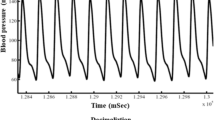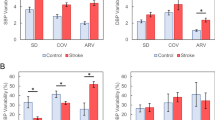Abstract
Baroreflex sensitivity (BRS) is impaired and of prognostic value in cerebrovascular disease. However, no studies to date have been published on the reproducibility of current methods of measuring BRS in this group. The reproducibility of sequence and spectral analysis methods were therefore assessed in subjects with cerebrovascular disease. A total of 14 subjects were assessed on 2 separate occasions at least 2 weeks apart, and beat-to-beat blood pressure (BP) and ECG trace were recorded for three 5-minute periods. These traces were then analyzed by spectral analysis using Fast Fourier Transform and sequence analysis. Reproducibility was calculated as the coefficient of variation (CV) and reproducibility coefficient (RC). There were no significant differences in heart rate, BP or BRS derived by either method between visits. Reproducibility was CV 22.2%, RC 6.04 ms/mmHg with spectral analysis, and CV 26.3%, RC 7.48 ms/mmHg for sequence analysis. There was close agreement between sequence and spectral derived BRS (r = 0.90). We have demonstrated that the use of spectral and sequence analysis to measure BRS is reproducible in subjects with cerebrovascular disease. These techniques are suitable for follow-up and intervention studies of BRS in this patient group.


Similar content being viewed by others
References
British Standards Institution: Precision of Test Methods I: Guide for the Determination and Reproducibility for a Standard Test Method (BS 5497, part 1). BSI, London, 1979
Bertinieri G, Di Rienzo M, Cavallazzi A, Ferrari AU, Pedotti A, Mancia G (1988) Evaluation of baroreceptor reflex by blood pressure monitoring in unanesthetized cats. Am J Physiol 254:H377–H383
Bland JM, Altman DG (1986) Statistical methods for assessing agreement between two methods of clinical measurement. Lancet 1:307–310
Bristow JD, Honour AJ, Pickering GW, Sleight P, Smyth HS (1969) Diminished baroreflex sensitivity in high blood pressure. Circulation 39:48–54
Britton M, Carlsson A, de Faire U (1986) Blood pressure course in patients with acute stroke and matched controls. Stroke 17:861–864
Colombo R, Mazzuero G, Spinatonda G, Lanfranchi P, Giannuzzi P, Ponikowski P, Coats AJ, Minuco G (1999) Comparison between spectral analysis and the phenylephrine method for the assessment of baroreflex sensitivity in chronic heart failure. Clin Sci (Lond) 97:503–513
Davies LC, Francis D, Jurak P, Kara T, Piepoli M, Coats AJ (1999) Reproducibility of methods for assessing baroreflex sensitivity in normal controls and in patients with chronic heart failure. Clin Sci (Lond) 97:515–522
Dawson SL, Potter JF (1998) Reproducibility of noninvasive baroreceptor sensitivity measurement. Am J Hypertens 11:129–130
Dawson SL, Robinson TG, Youde JH, James MA, Martin A, Weston P, Panerai R, Potter JF (1997) The reproducibility of cardiac baroreceptor activity assessed non-invasively by spectral sequence techniques. Clin Auton Res 7:279–284
Farrell TG, Odemuyiwa O, Bashir Y, Cripps TR, Malik M, Ward DE, Camm AJ (1992) Prognostic value of baroreflex sensitivity testing after acute myocardial infarction. Br Heart J 67:129–137
Gao SA, Johansson M, Hammaren A, Nordberg M, Friberg P (2005) Reproducibility of methods for assessing baroreflex sensitivity and temporal QT variability in end-stage renal disease and healthy subjects. Clin Auton Res 15:21–28
Harrington F, Murray A, Ford GA (2000) Relationship of baroreflex sensitivity and blood pressure in an older population. J Hypertens 18:1629–1633
Herpin D, Ragot S (1997) Mid- and long-term reproducibility of noninvasive measurements of spontaneous arterial baroreflex sensitivity in healthy volunteers. Am J Hypertens 10:790–797
Hughson RL, Quintin L, Annat G, Yamamoto Y, Gharib C (1993) Spontaneous baroreflex by sequence and power spectral methods in humans. Clin Physiol 13:663–676
Imholz BP, Wieling W, Langewouters GJ, van Montfrans GA (1991) Continuous finger arterial pressure: utility in the cardiovascular laboratory. Clin Auton Res 1:43–53
Imholz BP, Wieling W, van Montfrans GA, Wesseling KH (1998) Fifteen years experience with finger arterial pressure monitoring: assessment of the technology. Cardiovasc Res 38:605–616
James MA, Panerai RB, Potter JF (1998) Applicability of new techniques in the assessment of arterial baroreflex sensitivity in the elderly: a comparison with established pharmacological methods. Clin Sci (Lond) 94:245–253
Jansen PA, Schulte BP, Poels EF, Gribnau FW (1987) Course of blood pressure after cerebral infarction and transient ischemic attack. Clin Neurol Neurosurg 89:243–246
Korpelainen JT, Sotaniemi KA, Suominen K, Tolonen U, Myllylä VV (1994) Cardiovascular autonomic reflexes in brain infarction. Stroke 25:787–792
Laitinen T, Hartikainen J, Vanninen E, Niskanen L, Geelen G, Lansimies E (1998) Age and gender dependency of baroreflex sensitivity in healthy subjects. J Appl Physiol 84:576–583
Lipman RD, Salisbury JK, Taylor JA (2003) Spontaneous indices are inconsistent with arterial baroreflex gain. Hypertension 42:481–487
Lord SW, Clayton RH, Hall MC, Gray JC, Murray A, McComb JM, Kenny RA (1998) Reproducibility of three different methods of measuring baroreflex sensitivity in normal subjects. Clin Sci (Lond) 95:575–581
Mortara A, La Rovere MT, Pinna GD, Prpa A, Maestri R, Febo O, Pozzoli M, Opasich C, Tavazzi L (1997) Arterial baroreflex modulation of heart rate in chronic heart failure: clinical and hemodynamic correlates and prognostic implications. Circulation 96:3450–3458
Oppenheimer S (2003) Vasculocentricity versus cerebrocentricity: what stroke-related baroreceptor reflex sensitivity changes might be telling us. Stroke 34:705–712
Parati G, Saul JP, Di Rienzo M, Mancia G (1995) Spectral analysis of blood pressure and heart rate variability in evaluating cardiovascular regulation. A critical appraisal. Hypertension 25:1276–1286
Parlow J, Viale JP, Annat G, Hughson R, Quintin L (1995) Spontaneous cardiac baroreflex in humans. Comparison with drug-induced responses. Hypertension 25:1058–1068
Pitzalis MV, Mastropasqua F, Passantino A, Massari F, Ligurgo L, Forleo C, Balducci C, Lombardi F, Rizzon P (1998) Comparison between noninvasive indices of baroreceptor sensitivity and the phenylephrine method in post-myocardial infarction patients. Circulation 97:1362–1367
Robbe HW, Mulder LJ, Ruddel H, Langewitz WA, Veldman JB, Mulder G (1987) Assessment of baroreceptor reflex sensitivity by means of spectral analysis. Hypertension 10:538–543
Robinson TG, Dawson SL, Eames PJ, Panerai RB, Potter JF (2003) Cardiac baroreceptor sensitivity predicts long-term outcome after acute ischemic stroke. Stroke 34:705–711
Robinson TG, James MA, Youde J, Panerai RB, Potter JF (1997) Cardiac Baroreceptor Sensitivity Is Impaired After Acute Stroke. Stroke 28:1671–1676
Rogoza AN, Pavlova TS, Sergeeva MV (2000) Validation of A&D UA-767 device for the self-measurement of blood pressure. Blood Press Monit 5:227–231
Smyth HS, Sleight P, Pickering GW (1969) Reflex regulation of arterial pressure during sleep in man. A quantitative method of assessing baroreflex sensitivity. Circ Res 24:109–121
Steptoe A, Vogele C (1990) Cardiac baroreflex function during postural change assessed using non-invasive spontaneous sequence analysis in young men. Cardiovasc Res 24:627–632
Watkins LL, Grossman P, Sherwood A (1996) Noninvasive assessment of baroreflex control in borderline hypertension. Comparison with the phenylephrine method. Hypertension 28:238–243
Author information
Authors and Affiliations
Corresponding author
Rights and permissions
About this article
Cite this article
Johnson, P., Shore, A., Potter, J. et al. Baroreflex sensitivity measured by spectral and sequence analysis in cerebrovascular disease. Clin Auton Res 16, 270–275 (2006). https://doi.org/10.1007/s10286-006-0351-6
Received:
Accepted:
Published:
Issue Date:
DOI: https://doi.org/10.1007/s10286-006-0351-6




